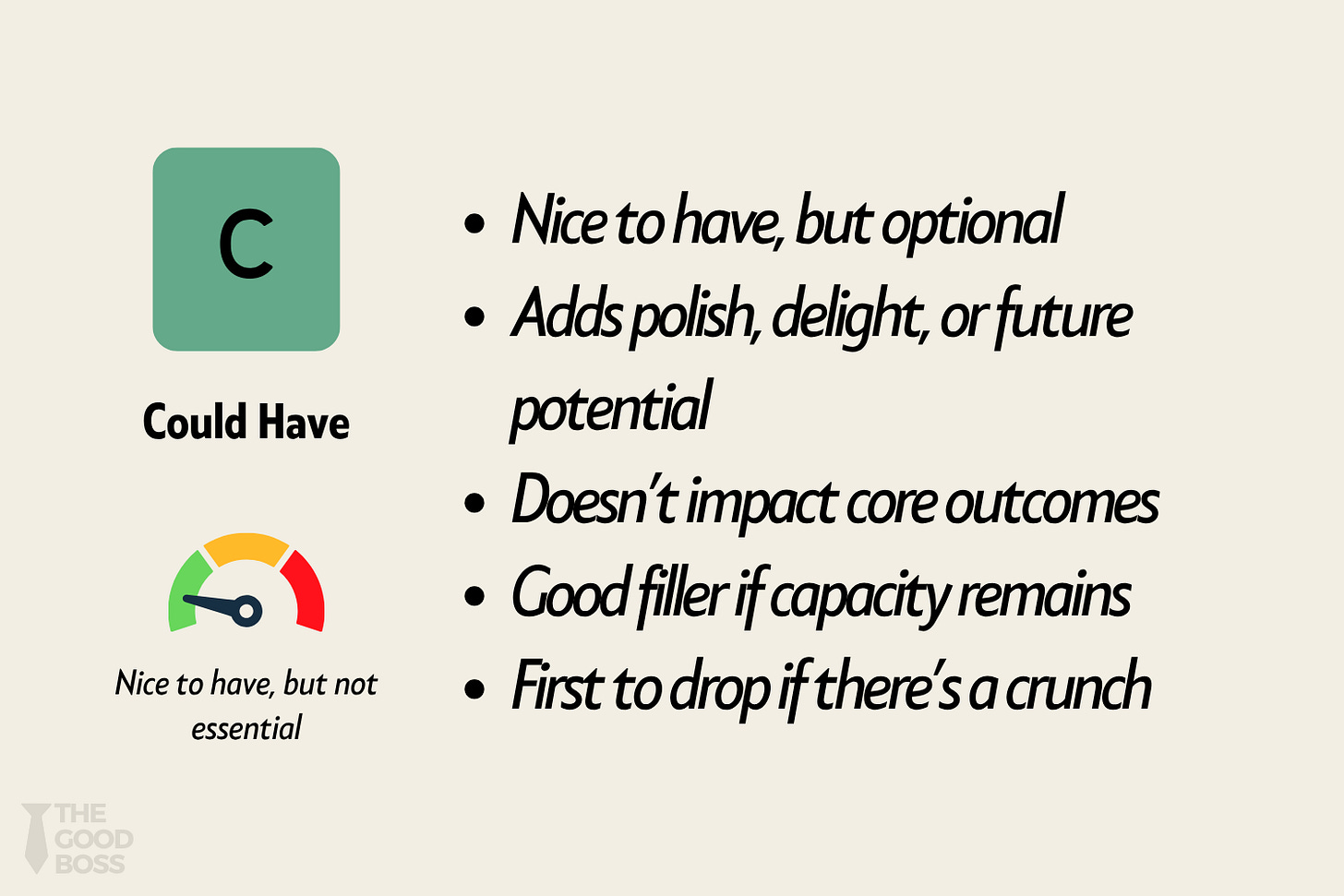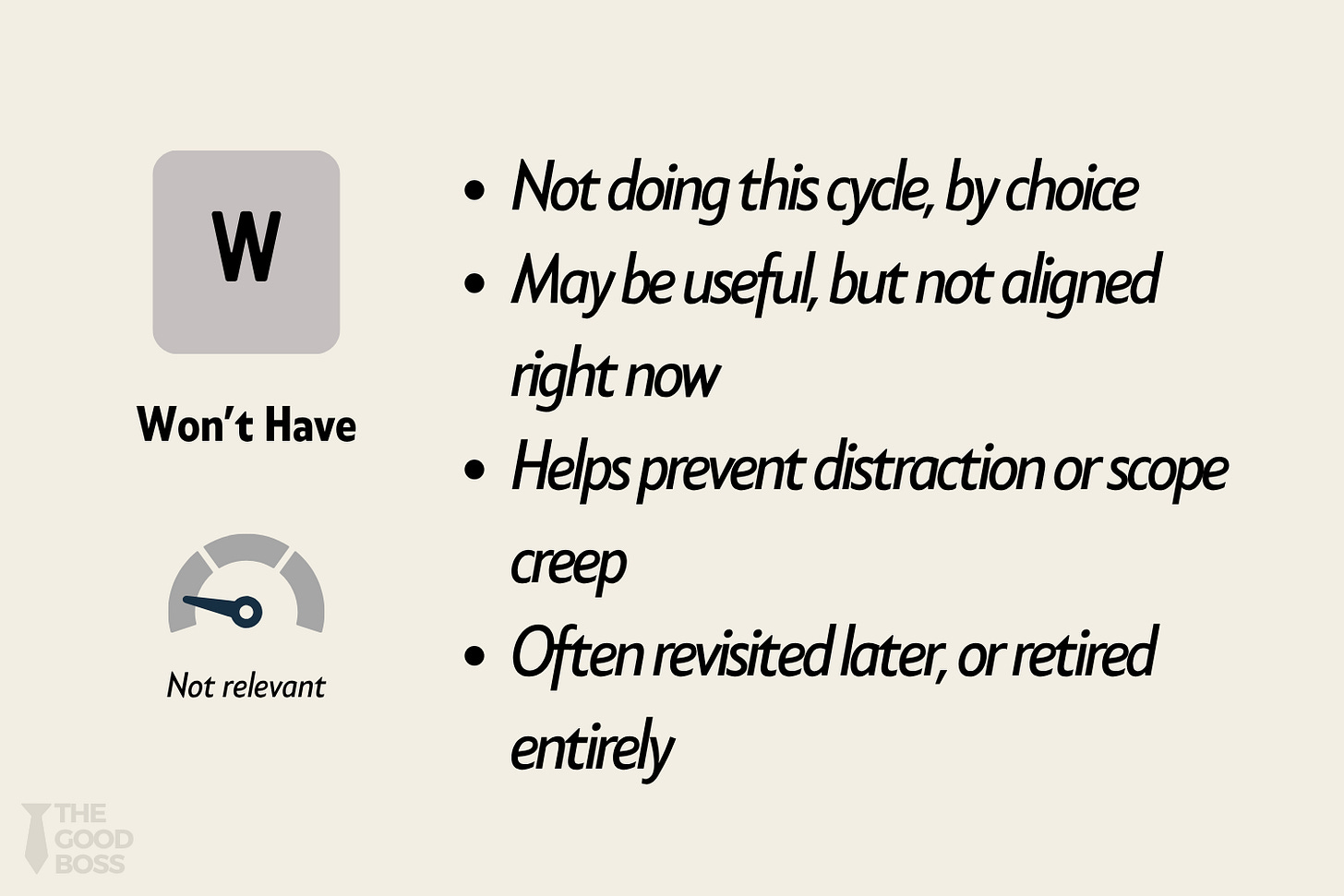The MoSCoW Method: How to Make Tough Choices Without the Guilt
A simple 4-part framework to prioritize what matters, and drop what doesn’t.
In this issue:
Part 1: Understanding the MoSCoW Method
What is the MoSCoW Method?
How the MoSCoW Method Works
Part 2: Applying the MoSCoW Method
The 5-Step Bucketing Approach
Real-Life Leadership Scenarios
The MoSCoW Method Worksheet
Part 3: Going from here
Common Pitfalls and How to Avoid Them
Recommended Resources
Final Takeaway
✨
Have you ever faced a stack of competing priorities, and every single one feels like a "must"?
You’re planning the next quarter. PMs want new features. Sales is pushing for faster releases. Finance is asking for cost cuts. Leadership is breathing down your throat. And your team, well, they're gasping for air.
You stare at your roadmap and ask: “What the hell do we cut?”
That’s the real job of a leader: making trade-offs, saying “no” when you’re expected to say “yes,” and doing all this without burning out your team, or yourself.
I think that fundamentally, most teams don’t have a prioritization problem. They have a guilt problem. This is:
The guilt of saying no.
The fear of disappointing someone.
The worry that we might get it wrong.
And this is where the MoSCoW Method comes in.
In this article, we will dive into this powerful prioritization framework, and build our muscle to apply it in our leadership roles.
Ready? Let’s dive in.
Part 1: Understanding the MoSCoW Method
What is the MoSCoW Method?
Let me get one thing out of the way: the MoSCoW method has nothing to do with Moscow, the city in Russia.
MoSCoW is an acronym for:
Must have
Should have
Could have
Won’t have (for now)
Dai Clegg first introduced this framework at Oracle in the mid-1990s for software development. But it’s now widely used across a range of prioritization decisions in agile planning, business strategy, and increasingly, leadership.
It helps you look at a long list of tasks, features, ideas, or goals and sort them into four clear buckets.
It’s that simple, and even more powerful.
How the MoSCoW Method Works
Remember the prioritization meeting where you started with twenty goals, and ended up marking fifteen of them (okay, I’m exaggerating, but you get the point) as ‘high priority’?
The beauty of the MoSCoW method is that it forces clarity. It forces you to make trade-offs up front, not later when it’s painful. And it does this through four simple buckets.
Let’s look at each of them one by one.
Must Have
These are non-negotiables. If you don’t deliver these, the entire project could fail, or lose its meaning. Think of things like:
Legal or compliance requirements
Payment or login functionality in an app
Critical bug fixes with customer-facing impact
Infrastructure that everything else depends on
These items are the backbone of your system, and you can’t afford to let them slip. Unless, of course, you want that to happen.
One tip I’ve found useful is to keep very few things in this bucket (remember the Pareto principle?). Having fewer ‘must-haves’ will increase the chances of success.
Should Have
These are important, but not critical. They add a lot of value, but they won’t cause the project to collapse if skipped temporarily.
Examples:
UI polish
Notifications or reminders
Optional onboarding steps
Internal dashboards
“Should Haves” are often things your team or stakeholders really want, but that can wait a little if time or resources run tight.
This is your flex zone. If you have capacity left after the Must Haves, these go in next.
Be careful, though. In my experience, the should-haves are the ones that can creep into the must-haves if you’re not careful and intentional. The key is to be objective, not emotional, when deciding which bucket the item belongs in.
Could Have
These are the nice-to-haves. They’re sometimes pet projects or future-facing experiments. They might be helpful someday, but they’re not needed right now.
Think:
Fancy animations
Corner cases or features that are hardly used
Internal facing features
You’re not saying no forever, you’re just not committing today. Sometimes, you’ll revisit them later. Other times, you’ll be glad you didn’t waste the time.
This bucket serves as the parking lot of ideas or potential areas to look at once your must-have and should-have buckets dry out.
Won’t Have (for now)
This is the most underused and misunderstood bucket. And yet, as I mentioned earlier, it’s the most powerful.
What goes into this bucket? These are the things you're deliberately not doing this time. They may be good ideas. Some may even be must-haves, just for a future release.
But not right now.
Putting something in “Won’t Have” does two things:
It sets boundaries. It gives the team breathing room.
It prevents scope creep. Because it makes the trade-offs visible and explicit. You know what you’re not going to spend your time on.
This could be the most challenging bucket because it forces you to make those tough decisions.
Now that we have a fair idea about the MoSCoW method and how it works, let’s learn some of the strategies to apply this. How do you decide which budget an item falls in? That’s exactly what we will explore in the next section.
Enjoying the read? Hit the ❤️ button and share/restack 🔁 it with others who might find it helpful.
Subscribe to The Good Boss to get leadership insights and frameworks like this every week. Consider becoming a paid subscriber to support my work, and get access to a host of premium leadership resources. Thank you! 🙏
Part 2: Applying the MoSCoW Method
In this section, you will learn how to apply the MoSCoW method for prioritization in your role as a leader.
We will start by reviewing the 5-Step Bucketing Approach, a simple yet powerful process that you can start applying.
We will then discuss some common real-life leadership scenarios, and how you would apply this method in each of those.
Finally, we will make it real with the MoSCoW Method Worksheet, which will help you build your muscle in applying and using this method in your leadership role.
First, let’s understand the 5-Step Bucketing Approach to categorize your items into the four buckets.






